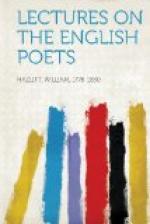The remarks which have been here made, would, in some measure, lead to a solution of the question of the comparative merits of painting and poetry. I do not mean to give any preference, but it should seem that the argument which has been sometimes set up, that painting must affect the imagination more strongly, because it represents the image more distinctly, is not well founded. We may assume without much temerity, that poetry is more poetical than painting. When artists or connoisseurs talk on stilts about the poetry of painting, they shew that they know little about poetry, and have little love for the art. Painting gives the object itself; poetry what it implies. Painting embodies what a thing contains in itself: poetry suggests what exists out of it, in any manner connected with it. But this last is the proper province of the imagination. Again, as it relates to passion, painting gives the event, poetry the progress of events: but it is during the progress, in the interval of expectation and suspense, while our hopes and fears are strained to the highest pitch of breathless agony, that the pinch of the interest lies.
“Between
the acting of a dreadful thing
And the first
motion, all the interim is
Like a phantasma
or a hideous dream.
The mortal instruments
are then in council;
And the state
of man, like to a little kingdom,
Suffers then the
nature of an insurrection.”
But by the time that the picture is painted, all is over. Faces are the best part of a picture; but even faces are not what we chiefly remember in what interests us most.—But it may be asked then, Is there anything better than Claude Lorraine’s landscapes, than Titian’s portraits, than Raphael’s cartoons, or the Greek statues? Of the two first I shall say nothing, as they are evidently picturesque, rather than imaginative. Raphael’s cartoons are certainly the finest comments that ever were made on the Scriptures. Would their effect be the same if we were not acquainted with the text? But the New Testament existed before the cartoons. There is one subject of which there is no cartoon, Christ washing the feet of the disciples the night before his death. But that chapter does not need a commentary! It is for want of some such resting place for the imagination that the Greek statues are little else than specious forms. They are marble to the touch and to the heart. They have not an informing principle within them. In their faultless excellence they appear sufficient to themselves. By their beauty they are raised above the frailties of passion or suffering. By their beauty they are deified. But they are not objects of religious faith to us, and their forms are a reproach to common humanity. They seem to have no sympathy with us, and not to want our admiration.
Poetry in its matter and form is natural imagery or feeling, combined with passion and fancy. In its mode of conveyance, it combines the ordinary use of language with musical expression. There is a question of long standing, in what the essence of poetry consists; or what it is that determines why one set of ideas should be expressed in prose, another in verse. Milton has told us his idea of poetry in a single line—




